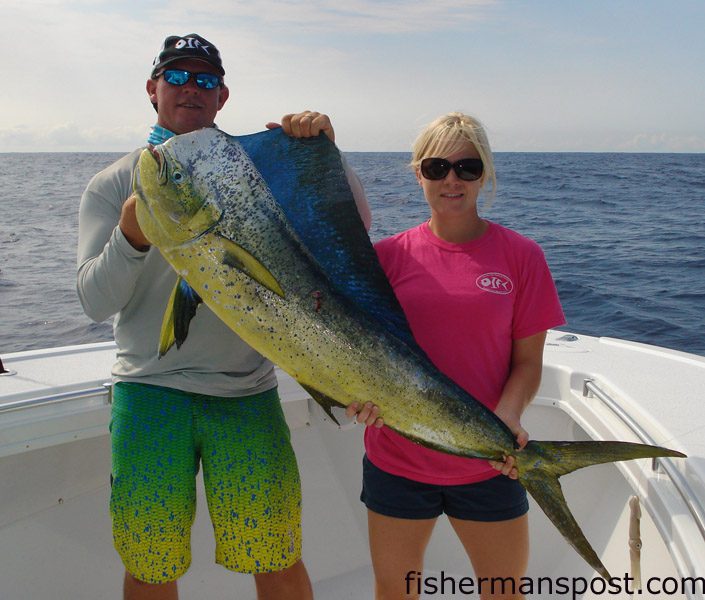The Best Month

Capt. Brant and Amy McMullan, of the Ocean Isle Fishing Center, with a bull dolphin that struck a trolled ballyhoo in the Gulf Stream off Ocean Isle in May.
I remember my dad used to tell his secretary to mark him off for the months of May and October. As far as he was concerned, those months were dedicated strictly to fishing, and as such, less important things like work would have to wait.
May is the best month for Gulf Stream trolling off our coast. The wahoo and blackfin are still hanging around in good numbers, if there are ever going to be yellowfin they will be here, and the dolphin begin their annual influx from the southern waters.
Ever wonder what happened to yellowfin tuna off southeastern North Carolina?
Last month at the Ocean Isle Fishing Center’s “Spring Kickoff” event, we had Michelle Duval with the NCDMF come speak on current and future fishery regulations. Of course, sea bass were a hot topic, but yellowfin tuna got brought up in the meeting as well. The question was asked, “What happened to the yellowfin?”
Michelle doesn’t serve on the HMS panels and thus did not have an answer at the ready, but she promised she would get one. Here is what she wrote:
“Apparently, this has been the case up and down the coast, not just in NC. I checked in with Randy Gregory, who sits on the HMS Advisory Panel, and he stated that the fish have just started to show up again in the Gulf of Mexico. However, it was discovered that there is a purse seine fishery for skipjack in the Gulf of Guinea (Africa), which is a major spawning area for yellowfin and unfortunately this fishery was catching a lot of 6 and 7 inch bigeye and yellowfin tuna. Regulations to control this fishery were just put in place last year, so hopefully we will begin to see some benefits in the not too distant future.”
I myself surmise that it is a covert government program that has placed anti-submarine beacons off our coast. There was talk of this program 5 or so years ago and quite a bit of dissention based on the effect it would have to whales. Everything suddenly got quiet as the program seemed to just go away. Coincidentally, the yellowfin numbers decreased dramatically just about this same time frame. I’m just saying.
Anyway, there actually have been some good reports of yellowfin being caught in the vicinity of the Swansboro Hole, and I am praying that they might slide down the break a little and give the Ocean Isle and Southport anglers a shot at them. It has been a LONG time since I’ve been wolfpacked by a school of yellowfin.
In other good news, I read a recent report that said the dolphin catches were very strong in the Bahamas this early spring, and indications were that the Carolina dolphin bite should be strong. There is just this one problem: Mother Nature. This spring has been very difficult to get offshore. I am only hoping that we are banking up good days of fishing, as we sure have been paying with the bad weather.
Grouper season has just opened up, and if you have defied the weather and been offshore, it is likely you’ve come back with good catches of grouper. If you do get out and want to target grouper, traditionally recreational effort is spent in the 90-120’ depth range. However, if you notice the commercial boats, you will see them camped out along the break in 150-300’.
The grouper bite is much better in this deeper water, but it is harder to effectively fish at these deeper depths. Anchoring for one is much harder, not to mention having to wind up another 50’+ of line with 16 or more ounces of lead on the end.
My recommendation is to get set up with a good vertical jigging outfit. You want to have at minimum 80 lb. braid, and be sure the reel can handle some serious drag. Vertical jigs in the 8-16 oz. size range with most of the weight on the bottom of the jig seem to work best. Also be sure to pick “glow” colors.
You now are set to attack a deep water fishery with relatively light equipment, and you don’t have to anchor to have success. It is important that the boat driver power the boat back into the drift to try to keep the boat over the structure but also keep the line angle close to 90 degrees. Vertical jigging is much more effective straight up and down, and as the line angle gets closer to 60 degrees, it is time to wind up and start over.
